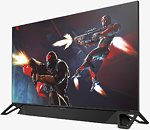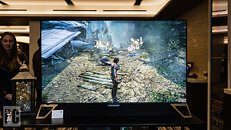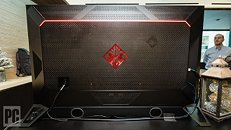Apr 27th, 2025 20:14 EDT
change timezone
Latest GPU Drivers
New Forum Posts
- overkill psu for 1080 ti /3090 (24)
- Hey all my intro & love for retro computers (27)
- RX 580 2048 SP BIOS (2)
- TPU's WCG/BOINC Team (34495)
- New PC: Instability and unexpected shutdowns when gaming. (17)
- Your PC ATM (35371)
- Do you guys have backup GPUs? (73)
- Are the 8 GB cards worth it? (357)
- Philips Dual QHD OLED 49M2C8900L/00 curved. (7)
- Have been having errors with PC for last 6 - 10 Months (15)
Popular Reviews
- Clair Obscur: Expedition 33 Performance Benchmark Review - 33 GPUs Tested
- Oblivion Remastered Handheld Performance Review
- NVIDIA GeForce RTX 5060 Ti 8 GB Review - So Many Compromises
- Crucial CUDIMM DDR5-6400 128 GB CL52 Review
- Upcoming Hardware Launches 2025 (Updated Apr 2025)
- Sapphire Radeon RX 9070 XT Pulse Review
- Sapphire Radeon RX 9070 XT Nitro+ Review - Beating NVIDIA
- AMD Ryzen 7 9800X3D Review - The Best Gaming Processor
- Colorful iGame B860M Ultra V20 Review
- ASUS GeForce RTX 5080 TUF OC Review
Controversial News Posts
- NVIDIA GeForce RTX 5060 Ti 16 GB SKU Likely Launching at $499, According to Supply Chain Leak (182)
- NVIDIA Sends MSRP Numbers to Partners: GeForce RTX 5060 Ti 8 GB at $379, RTX 5060 Ti 16 GB at $429 (127)
- NVIDIA Launches GeForce RTX 5060 Series, Beginning with RTX 5060 Ti This Week (115)
- Nintendo Confirms That Switch 2 Joy-Cons Will Not Utilize Hall Effect Stick Technology (105)
- Nintendo Switch 2 Launches June 5 at $449.99 with New Hardware and Games (99)
- Sony Increases the PS5 Pricing in EMEA and ANZ by Around 25 Percent (84)
- NVIDIA PhysX and Flow Made Fully Open-Source (77)
- Parts of NVIDIA GeForce RTX 50 Series GPU PCB Reach Over 100°C: Report (77)
News Posts matching #VRR
Return to Keyword Browsing
Microsoft Extends Variable Refresh Rate to Games that Lack Native Support
Microsoft extended variable refresh-rate (VRR) to games that don't natively support it, through a new global setting under Graphics Settings. To access this setting, you must have the latest Windows 10 May 2019 Update (version 1903), a display that supports NVIDIA G-Sync, AMD FreeSync, or VESA Adaptive-Sync, and a graphics processor with a WDDM 2.6-compliant driver that supports these VRR technologies. For now, this setting only works with DirectX 11 games in exclusive-fullscreen mode. Microsoft clarified that this setting is not designed to override the VRR options presented by the control panels of your display driver provider (eg: NVIDIA Control Panel or AMD Radeon Settings). The option is disabled by default, and isn't visible to users who don't meet both the hardware- and software-requirements of VRR.

HP Omen X Emperium 65 is the FIRST NVIDIA BFGD Product: 4K, HDR, G-SYNC, 144 Hz for $4,999
Product context: HP showcased their new and upcoming Omen X Emperium 65 at CES, an NVIDIA BFGD (Big Format Gaming Display) with all the features the company deems premium and attractive to gamers: 4K resolution, a huge, 65" diagonal AMVA panel, HDR (1,000 nits of peak luminance and 95 percent of the DCI-P3 color gamut) , G-Sync, and 120 - 144Hz refresh rate (144 Hz is overclocked) with a gray-to-gray response time is rated for 4ms. It features an incorporated sound bar with 120 W of power and three amps. An integrated NVIDIA Shield makes an appearance as well as a multimedia juggernaut solution. All of this in a $4,999 body, launching in February 2019.
Thoughts: Rollback. A $4,999 price-tag. Maybe this is just me, but NVIDIA seems to be finally introducing their BFGDs at the worst possible time, considering the company has just formally announced that their GeForce graphics cards would be finally supporting VESA's VRR (Variable Refresh Rate) standard. This brings with it FreeSync support - for monitors and, we'd expect, TV's as well, considering that the driver solution will be toggable by users even in a non-NVIDIA certified display.
Thoughts: Rollback. A $4,999 price-tag. Maybe this is just me, but NVIDIA seems to be finally introducing their BFGDs at the worst possible time, considering the company has just formally announced that their GeForce graphics cards would be finally supporting VESA's VRR (Variable Refresh Rate) standard. This brings with it FreeSync support - for monitors and, we'd expect, TV's as well, considering that the driver solution will be toggable by users even in a non-NVIDIA certified display.

Upcoming XBOX "Project Scorpio" to Support Freesync 2, HDMI 2.1 VRR
In what could spell very interesting things for the uptake of the Freesync 2 open-standard, Digital Foundry has confirmed that Microsoft's upcoming "Project Scorpio" console will leverage AMD's FreeSync 2 standard so as to improve fluidity of frames. The objective is, as usual, to eliminate tearing and reduce stutter, allowing the GPU to trigger the display refresh rate at exactly the same frequency as it can churn out frames. The FreeSync 2 revision of the open standard is HDR-compatible, which means it supports what is being touted as The Next Big Thing in image quality. Like always, the available FreeSync-supported band will still depend on the panel's actual specifications. Additionally, the Scorpio is going to offer support for the upcoming VRR (Variable Refresh Rate) implemented within the HDMI 2.1 specifications.
Though TV panels don't support either of those standards currently, AMD has teased that FreeSync support on TVs would be possible - and upcoming. If true, and if this FreeSync support were to take off, this might spell an increased uptake on AMD's open standard implementation of VRR over NVIDIA's G-SYNC. The adoption of these VRR technologies would also allow developers to perhaps change their performance targets (say, from 60 FPS to 45 FPS), while also increasing fluidity of games that struggle to maintain their target frame rate. The Scorpio could be the first mainstream piece of tech to offer widespread support for VRR standards, thus increasing the user base and industry adoption rate of this technologies, which can only be good. To say that this adoption spells the death of NVIDIA's proprietary G-SYNC is nothing more than wild, boastful speculation; saying it could drive FreeSync and HDMI's VRR implementation towards mainstream usage is not. And that could mean a slow push of G-SYNC towards a niche PC-monitor solution with reduced uptake from monitor manufacturers.
Though TV panels don't support either of those standards currently, AMD has teased that FreeSync support on TVs would be possible - and upcoming. If true, and if this FreeSync support were to take off, this might spell an increased uptake on AMD's open standard implementation of VRR over NVIDIA's G-SYNC. The adoption of these VRR technologies would also allow developers to perhaps change their performance targets (say, from 60 FPS to 45 FPS), while also increasing fluidity of games that struggle to maintain their target frame rate. The Scorpio could be the first mainstream piece of tech to offer widespread support for VRR standards, thus increasing the user base and industry adoption rate of this technologies, which can only be good. To say that this adoption spells the death of NVIDIA's proprietary G-SYNC is nothing more than wild, boastful speculation; saying it could drive FreeSync and HDMI's VRR implementation towards mainstream usage is not. And that could mean a slow push of G-SYNC towards a niche PC-monitor solution with reduced uptake from monitor manufacturers.
Apr 27th, 2025 20:14 EDT
change timezone
Latest GPU Drivers
New Forum Posts
- overkill psu for 1080 ti /3090 (24)
- Hey all my intro & love for retro computers (27)
- RX 580 2048 SP BIOS (2)
- TPU's WCG/BOINC Team (34495)
- New PC: Instability and unexpected shutdowns when gaming. (17)
- Your PC ATM (35371)
- Do you guys have backup GPUs? (73)
- Are the 8 GB cards worth it? (357)
- Philips Dual QHD OLED 49M2C8900L/00 curved. (7)
- Have been having errors with PC for last 6 - 10 Months (15)
Popular Reviews
- Clair Obscur: Expedition 33 Performance Benchmark Review - 33 GPUs Tested
- Oblivion Remastered Handheld Performance Review
- NVIDIA GeForce RTX 5060 Ti 8 GB Review - So Many Compromises
- Crucial CUDIMM DDR5-6400 128 GB CL52 Review
- Upcoming Hardware Launches 2025 (Updated Apr 2025)
- Sapphire Radeon RX 9070 XT Pulse Review
- Sapphire Radeon RX 9070 XT Nitro+ Review - Beating NVIDIA
- AMD Ryzen 7 9800X3D Review - The Best Gaming Processor
- Colorful iGame B860M Ultra V20 Review
- ASUS GeForce RTX 5080 TUF OC Review
Controversial News Posts
- NVIDIA GeForce RTX 5060 Ti 16 GB SKU Likely Launching at $499, According to Supply Chain Leak (182)
- NVIDIA Sends MSRP Numbers to Partners: GeForce RTX 5060 Ti 8 GB at $379, RTX 5060 Ti 16 GB at $429 (127)
- NVIDIA Launches GeForce RTX 5060 Series, Beginning with RTX 5060 Ti This Week (115)
- Nintendo Confirms That Switch 2 Joy-Cons Will Not Utilize Hall Effect Stick Technology (105)
- Nintendo Switch 2 Launches June 5 at $449.99 with New Hardware and Games (99)
- Sony Increases the PS5 Pricing in EMEA and ANZ by Around 25 Percent (84)
- NVIDIA PhysX and Flow Made Fully Open-Source (77)
- Parts of NVIDIA GeForce RTX 50 Series GPU PCB Reach Over 100°C: Report (77)






